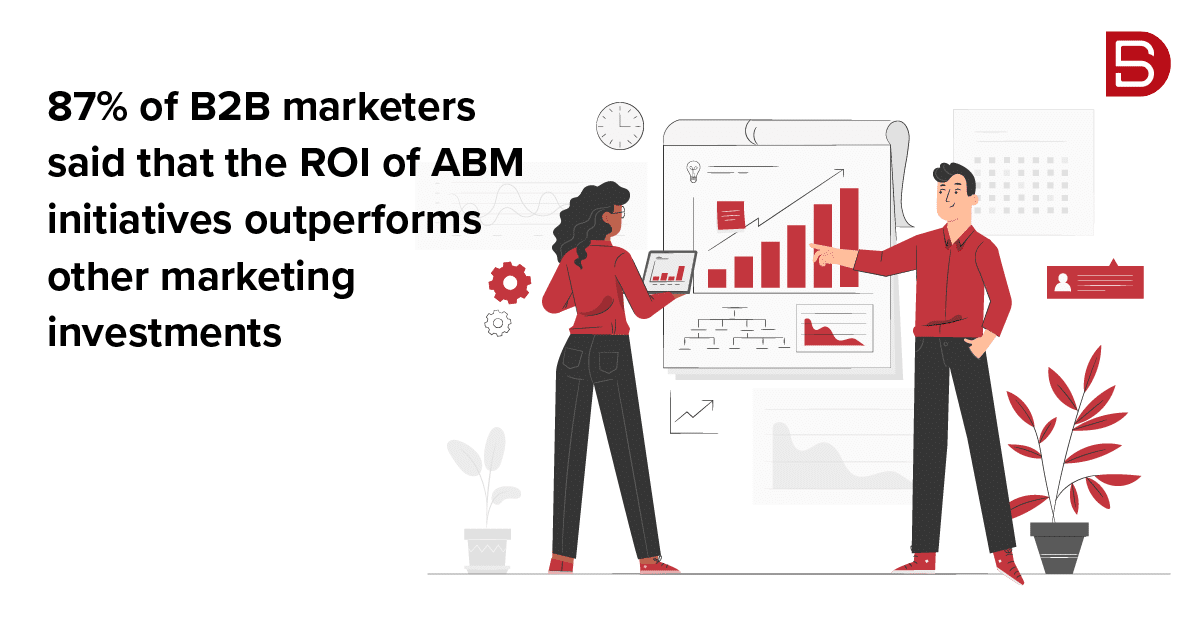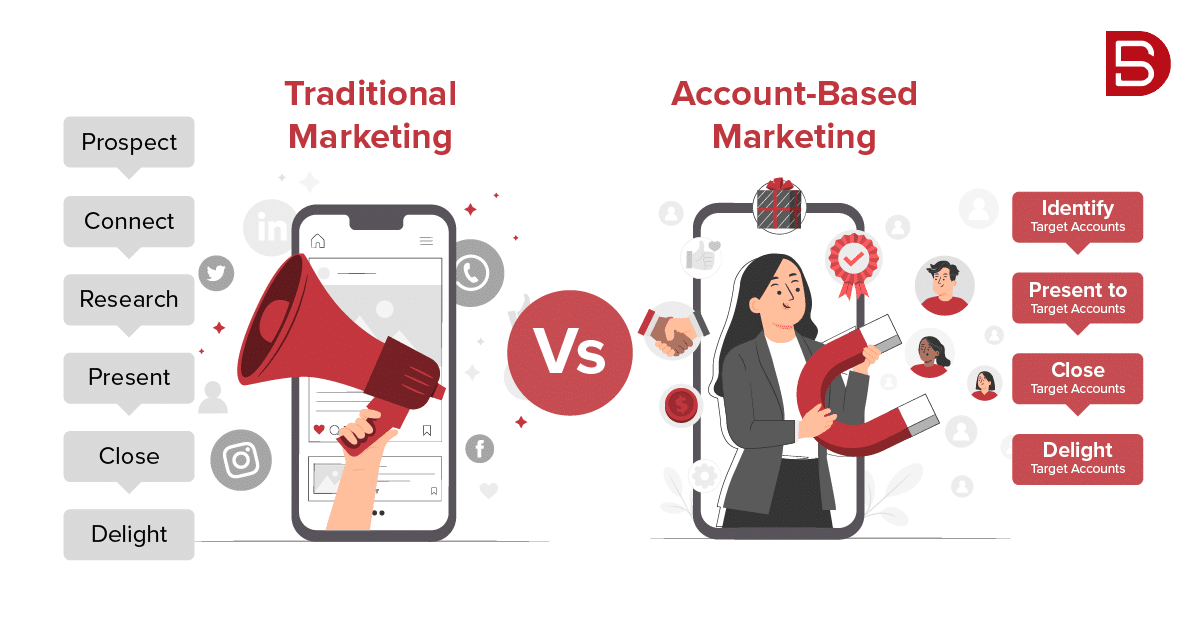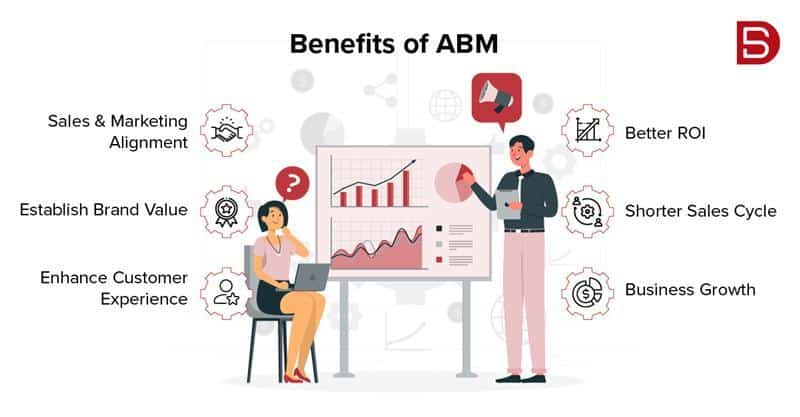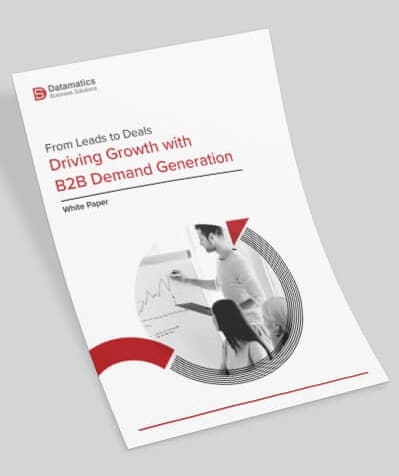Have you ever considered how B2B brands effectively convert valuable leads into devoted customers? The key lies in creating tailored experiences that attract B2B decision-makers and provide excellent value. Enter Account-Based Marketing (ABM) – the ultimate B2B sales and marketing strategy.
ABM involves collaboration between sales and marketing to engage specific target accounts that align well with the brand. It’s a highly focused approach that aims to convert high-value prospects into satisfied customers.
However, mastering ABM requires a learning curve. That’s why it’s essential to understand its nuances. In this blog we will delve into ABM, discuss its advantages, and share a few tried and tested account-based marketing strategies.
What is Account-Based Marketing?
Account-Based Marketing (ABM) is a strategic approach focusing on targeting and engaging specific high-value accounts or companies rather than casting a wide net to a larger audience. In ABM, marketing and sales teams work closely to identify key accounts, understand their unique needs, and create personalized campaigns to address them.
ABM involves tailoring marketing efforts to resonate with each target account’s individual needs and challenges. This can include creating customized content, personalized outreach, and specialized offers. The goal is to establish deeper relationships with decision-makers within these accounts, leading to higher conversion rates and stronger customer loyalty.
Now before delving into ABM framework and its effective strategies, let’s explore its relationship with another crucial strategy: inbound marketing.
The Dynamic Duo: Account-Based Marketing & Inbound Marketing
When combined, account-based marketing and inbound marketing have the potential to create positive waves for your company.
You may be wondering how exactly this partnership functions. We just went over the definition of account-based marketing, and as we know, it is a highly targeted strategy. Meanwhile, inbound marketing is more fundamental; this methodology and growth strategy allow you to attract customers by creating valuable content, using SEO, and providing a delightful customer experience.
Rather than interrupting your target audience and customers (as you would with outbound marketing), inbound marketing allows you to more organically provide your audience with the information they want when they want it. Inbound lays the foundation for a strong ABM strategy by allowing for highly targeted and efficient resource allocation of high-value accounts.
With this combined approach, you attract a larger group of prospects than you would with just one method. Additionally, you can produce and use content that supports both an ABM and an inbound strategy, giving your content a two-for-one value (e.g., draft a tailored case study for a particular account that you also post on your website).
A Holistic Account-Based Marketing Framework
ABM operates in a different way than a conventional sales funnel. Although ABM can be used in various businesses and industries, a general framework must be followed to guarantee its efficacy. Here are the critical components of an account-based marketing framework:
Alignment of Sales & Marketing
The significance of alignment between the sales and marketing departments cannot be overstated. They need to be on the same page to implement an all-encompassing ABM strategy and guarantee that target accounts have a positive buying experience.
When putting ABM into practice, sales and marketing folks must agree on resource allocation for each target account, role, and responsibility assignment to ensure a smooth transition for the customer between marketing and sales activities. This will help them to decide how to measure the success of their efforts.
Account Qualification
What criteria does your business use to identify high-value accounts? The key to answering this question and developing an ABM framework is to establish an ideal customer profile for the accounts your business wants to target. It’s also worth noting that both marketing and sales should be involved in these discussions.
Consider the following factors as you decide what qualifies a potential account:
- Financials: Consider the potential revenue from an account while keeping in mind your company’s sales objectives.
- Scalability: Based on what you know about the account’s potential business performance, is it possible to grow the account in the future? Consider any additional services your business could offer to keep and expand the account.
- Competitor Analysis: Who are your competitors selling to in the market? You can find potential future account opportunities by knowing who is currently in the market for products and services like yours.
Marketing Strategy
Once sales and marketing are on the same page with their game plan and the accounts they’re targeting, it’s time to craft a strategy for hitting the market.
Think about how a potential new customer would go through the sales process using the ABM method. This can uncover any hitches that need fixing or spots where communication could use a boost before you dive into the market.
And remember, because giving that personal touch is like the secret sauce in account-based marketing, your team should be on the lookout for latest marketing trends to sprinkle in even more value and make these accounts feel extra special.
Noteworthy Benefits of Account-Based Marketing
Account-based marketing comes with many advantages. We’ve compiled a list of commonly observed outcomes that benefit all businesses.
1. Sales & Marketing Alignment
Any organization can grow with improved communication and cross-team collaboration. In account-based marketing, being open and on the same page means your marketing and sales squads aim for the same bullseye. It ensures that both teams work toward the same goals, stay within a mutually agreed budget, and understand the specific roles of each internal stakeholder.
This alignment ensures that all of your interactions, communications, and content are consistent for your accounts. The ability of your team members to seamlessly pick up where others left off at any time, regardless of how long an account has been working with your business, ensures a seamless and satisfying customer experience.
2. Establish Brand Value
With ABM, it’s all about giving everything a personal touch (content, product details, chats, and campaigns) for every account that gets your attention. This personal touch is the magic ingredient that makes your presence really count for these accounts.
Why? By tailoring your content and chats, you’re showing them that your products, services, and other goodies are a perfect match for their issues. Simply put, ABM lets you position your company as the go-to choice that hits the bullseye for your target accounts.
3. Enhance Customer Experience
In the world of ABM, your game plan has to be about keeping your accounts smiling for the long haul. Every account should feel like they’re your one and only customer. And how do you do that? By giving them the same great experience every time.
ABM needs your sales and marketing to be like two peas in a pod. So, make sure everyone knows where an account is on their journey. Then, dish out tailored messages, campaigns, product info, and prices right on the money and on time.
4. Better ROI
Implementing an ABM strategy that targets high-value accounts significantly boosts Return on Investment (ROI). By directing marketing resources towards a carefully selected group of high-potential accounts, businesses can maximize their efforts where they matter most. This approach results in efficient resource allocation, higher conversion rates, and shorter sales cycles.
5. Shorter Sales Cycle
When you tailor your ABM efforts to target accounts that align closely with your solutions, you’re narrowing your focus to those more likely to be in the advanced stages of their buying journey. These accounts are likely facing challenges that your offerings can directly address. As a result, they are closer to making a purchase decision than leads that may still be in the early stages of exploration.
By focusing on accounts already primed for a decision, ABM helps you bypass the typical lengthy sales cycle stages. This acceleration is driven by your personalized messaging, content, and engagement strategies aligning with their immediate needs and concerns. As a result, the time it takes for these accounts to move from initial interest to closing the deal is shortened.
6. Business Growth
Account-based marketing fits the adage “quality over quantity.” Instead of attempting to quickly close deals with less-qualified leads who might not be the best fit for your company in the long run, the process requires you to invest a significant amount of time and resources in interacting with and nurturing a group of carefully selected, high-value accounts.
By investing the time to create these reliable connections with customers, you’ll grow your business by keeping those priceless clients for longer. This will boost your bottom line because acquiring customers is more expensive than keeping them.
Additionally, over time, accounts will become loyal to your company due to personalized, considerate, and consistent customer experiences, and loyal customers turn into your best marketers, promoters, and brand advocates. In other words, through referrals, word-of-mouth advertising, testimonials, and other methods, your accounts will aid in your company’s growth among its networks (such as partners and customers).
Now, let’s look at some account-based marketing strategies you can incorporate to increase your chances of success.
Account-Based Marketing Strategies for Nurturing High-Value Accounts
ABM strategies are the foundation of ensuring high-quality leads; therefore, go through the following list to ensure the success of your ABM efforts and investment.
1. Secure Organizational ABM Alignment
This is undoubtedly one of the most crucial account-based marketing strategies. It entails gaining the support of all internal stakeholders for the various aspects of your account-based marketing strategy. By doing this, your company will find it simpler to provide customers with consistent experiences and ensure your strategy is as effective and streamlined as possible.
2. Identify High-value Accounts
Choose the ideal group of high-value target accounts to devote your time and resources.
Here are some ideas on how to go about doing this:
- Create LinkedIn search alerts for the profile of your ideal client.
- Create a workflow that categorizes incoming qualified leads into ideal customer types in your CRM based on a set of criteria (such as company size, industry, etc.).
- Find out which deal from the previous year you would like to replicate. Use the characteristics of that deal (such as the industry, company size, and value) to help you find additional clients who would be a good fit.
- Choose your targeted audience based on their industry or location.
- Analyze major companies and leads that are using and engaging with your inbound content but do not have a deal (yet!).
- Determine which lighthouse accounts you could use as a reference.
3. One-on-One Outreach
This is not about sending out cookie-cutter messages but tailoring your approach to each account’s needs, like a personalized gift. Reach out to the decision-makers, whether it’s through direct messages, emails, or even a good old-fashioned phone call – whatever they prefer.
The goal is to build a solid relationship by addressing their pain points and showing how your solutions align perfectly. Working closely with your sales team and being patient pays off; these conversations aren’t just about instant results but about nurturing a connection that can lead to fruitful collaborations down the road.
4. Long-term Relationship Building
Once you’ve attracted those top-tier clients, the focus shifts to building lasting relationships with their purchasing teams. This isn’t an overnight job; cultivating these connections often takes months or even years. It is an ongoing strategy centered on consistently delivering exceptional client experiences.
The goal is to keep them delighted throughout their journey, creating an enduring bond that stands the test of time. Here are some ideas on how to establish a solid, long-lasting rapport with a buying committee:
- Through tailored interactions and engagement, provide education about the value your company and your product/service bring to account.
- Create and distribute individualized content, such as case studies, to demonstrate how you will exceed expectations and overcome each account’s challenges.
- Communicate one-on-one with buying committee members to make them feel they are your only priority.
- Host events with and for account members so they can get to know you and your team better.
- Keep meetings organized and on time. Be professional, consistent, and use email sequencing to improve all communication.
5. Measure & Analyze Your ABM Efforts
It would be best to track your progress while working through and after completing the account-based marketing strategies listed above. You can identify any gaps or parts of your strategy that need to be changed by reviewing and analyzing your ABM results. This will allow you to improve the effectiveness of your strategy for your company, marketing and sales teams, and accounts.
Here are some examples of common account-based marketing KPIs that provide insight into how you’re doing:
- Account Engagement Score: Create a score that reflects the level of engagement each target account has with your content, emails, website, and other touchpoints. This score helps prioritize accounts that are showing the most interest.
- Account Conversion Rate: Measure the percentage of target accounts progressing from initial engagement to becoming qualified leads, opportunities, or customers.
- Deal Velocity: Track the speed at which target accounts move through the sales pipeline. Faster movement indicates effective engagement and alignment between marketing and sales efforts.
- Account Retention Rate: For existing customers, measure how well your ABM efforts contribute to retaining and expanding relationships with these accounts over time.
- Closed-Won Percentage: Calculate the percentage of target accounts successfully closed as customers. This KPI directly ties revenue generation to your ABM efforts.
- ROI on ABM Campaigns: Assess the return on investment for your ABM campaigns by comparing the revenue generated from ABM-driven deals to the costs of executing those campaigns.
6. Add the Touch of Personalization
Given the targeted nature of account-based marketing, programs must deliver high conversion rates. One efficient strategy for doing this is personalizing landing pages. Marketers can design landing pages that are tailored to specific accounts, displaying personalized copy, images, offers, and forms according to the account or person who is accessing the page.
Personalization strategies can include displaying the visitor’s name on the landing page — but be cautious, as some prospects may find this too intrusive.
7. Create Compelling Offers
Almost universally, a vast majority of marketers engage in the practice of creating compelling incentives that are strategically designed to result in scheduled meetings. These incentives often take the form of webinars and white papers, serving as valuable resources that sales teams leverage to convince potential customers to agree to a conversation. As an example, let’s consider a company specializing in lead generation.
They could offer businesses a set of complimentary leads as a means to capture the attention and interest of these businesses, effectively prompting them to explore the company’s offerings further and potentially leading to productive discussions.
8. Collaborate Sales & Marketing
Collaborative sales and marketing efforts form the cornerstone of successful ABM strategies. This approach revolves around forging a seamless partnership between these two critical departments within an organization. By closely aligning sales and marketing teams, companies can leverage their collective expertise to engage with target accounts in a more impactful manner.
Through open communication, sharing of insights, and joint planning, both teams gain a comprehensive understanding of the account’s needs, pain points, and preferences. This synergy ensures that the messaging and content delivered to the account are cohesive, relevant, and tailored to their specific challenges.
This collaborative approach not only enhances the customer experience but also maximizes the potential for successful engagement and long-term partnerships.
9. Leverage Data-Driven Insights
Data-driven insights play a pivotal role in refining ABM strategies. By harnessing the power of data and advanced analytics, companies can delve deep into an account’s behavior, preferences, and interactions. This information empowers them to make informed decisions about how to engage effectively.
By tracking digital footprints, website visits, content consumption patterns, and social media interactions, companies can decipher the account’s specific interests and pain points. This knowledge enables them to tailor outreach efforts with precision, offering content and solutions that directly resonate with the account’s needs. Additionally, historical data can reveal the most opportune times for engagement, whether it’s sending an email, making a call, or organizing a meeting.
10. Run Account-Specific Campaigns
Account-specific campaigns are a strategic facet of ABM that involve tailoring advertising efforts to a particular target account. This approach goes beyond traditional mass marketing by creating campaigns that are exclusively directed at a specific organization. By leveraging data and insights, companies can identify the key stakeholders within the chosen account and design advertisements that address their unique pain points, objectives, and challenges.
These customized ads can be displayed across various digital platforms, ensuring that the account’s decision-makers encounter content that speaks directly to their needs. This level of personalization not only grabs their attention but also reinforces the brand’s presence in their minds.
By aligning the campaign’s messaging with the account’s priorities, businesses can establish credibility and showcase their commitment to solving the account’s issues. Ultimately, account-specific campaigns boost engagement, build trust, and enhance the likelihood of meaningful interactions, creating a solid foundation for fostering long-term partnerships.
Conclusion
In a world where personalization and relevance reign supreme, ABM emerges as a powerhouse strategy. It’s not just about casting a wide net; it’s about connecting with the right accounts in a way that speaks directly to their unique needs.
If you’re ready to take your marketing game to the next level, consider outsourcing your ABM efforts. Datamatics Business Solutions leverages comprehensive ABM lead generation tactics across various channels, aiming to pinpoint prospects that align closely with your business requirements and are highly likely to align with your strategic objectives. Write to us at marketing@datamaticsbpm.com to elevate your account-based marketing strategies.
 Select an element to maximize. Press ESC to cancel.
Select an element to maximize. Press ESC to cancel.
Courtney McCombs





